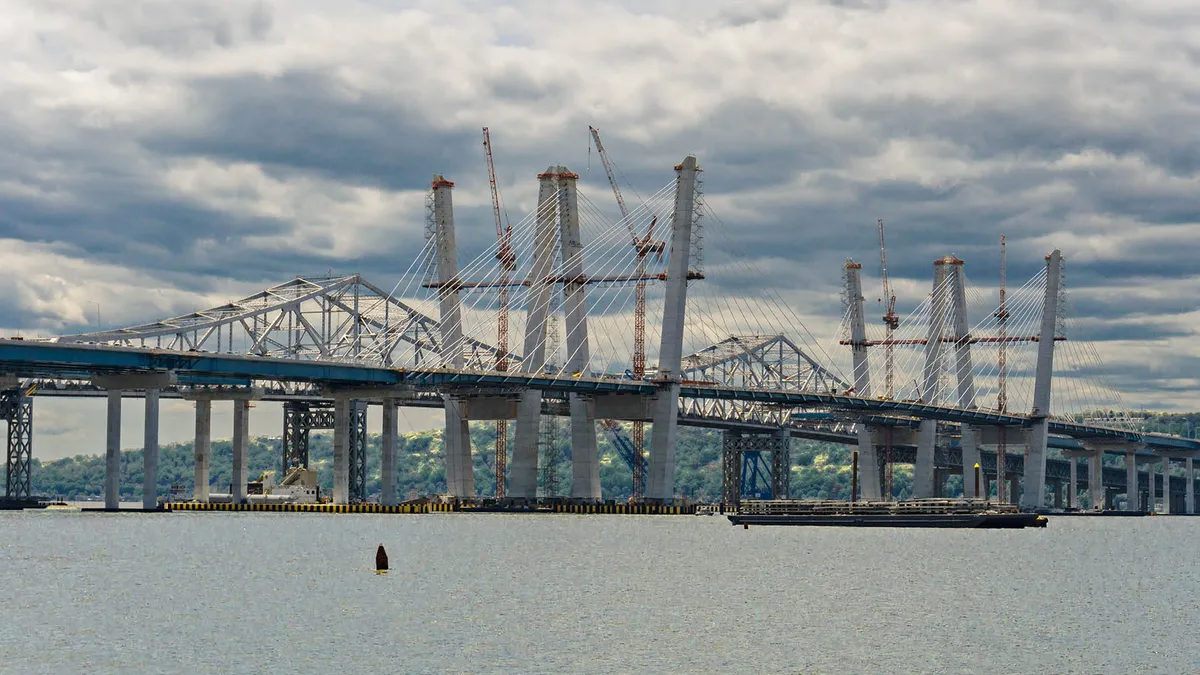Approaching the halfway mark of the year, the commercial construction industry is strong, staving off any premature cooling before an impending economic downturn and integrating innovation in relatively slow but steady measures all the time.
But what do experts anticipate for the rest of the year and going into next? Two presenters at last week’s ENR FutureTech conference in San Francisco offered their takes on where the industry is heading — some that mirror the trends Construction Dive anticipated going into the year, and some that represent minor shifts in the market.
Infrastructure spending is inevitable
Even though Congress and President Donald Trump can’t agree on how to fund infrastructure improvement projects, many are inevitable, and they will have a huge impact on the construction industry this year and into the future, according to presenter T.G. Jayanth, Capital Projects Expert at McKinsey & Co.
“It’s a well-known fact that infrastructure in this country is aging, it’s collapsing and breaking,” Jayanth said. Even though federal infrastructure legislation is still under debate, he is bullish on the segment, saying that general contractors that serve this part of the industry “are in the right place."
Another big trend — the growth of cities — is driving the need for more roads, transportation, green spaces and recreational and entertainment venues, he said. By 2030, about 65% of the world’s population will live in urban areas. “This creates a critical need for housing and infrastructure,” he noted.
The cost of such development is staggering, he said, with a global spend of about $2.5 trillion annually. Power, roads, telecommunications and water are the top four most in-demand types of infrastructure projects, according to McKinsey data.
The pricetag for many of these projects will increase up to 40% because they will be built to high levels of sustainability, Jayanth said, noting that resiliency will play an important role as extreme weather becomes the norm.
He predicts that resiliency standards will soon become a mandatory part of building codes in many areas and urged attendees to become aware of resilient techniques if they aren’t already. “All that it’s going to take is a couple more extreme weather events before lawmakers step in with legislation,” he said. “We’re very loosely regulated in this area now as resilience is not a requirement, but it will soon become a requirement."
Room for growth, one prefab room at a time
Modularization and off-site fabrication continue to be important drivers for the industry, Jayanth noted. The segment represents only a tiny fraction of the U.S. construction market, unlike in other countries where a third or more of the building stock incorporates factory-built technologies.
While U.S. modular projects have not yet achieved the promise of substantial cost savings, its scheduling efficiencies are “definitely real,” Jayanth said, with some projects achieving time-saving improvements of 20% to 50%.
While some construction execs view modularization and the firms that offer it — like Katerra, RAD Urban and Z Modular — as competition, Jayanth urged them to instead look at offsite methods as a growth area.
“In the U.S., modularization is only 3% of current construction,” he said. “By starting at such a small baseline you have the opportunity to get in and ride this wave of modularization.”
As an example, he mentioned the 26-story AC Hotel NoMad by Marriott, which will be the world’s tallest modular hotel when it is completed next year in New York City. The 168 prefabricated guest rooms will arrive on-site fully finished inside and outside and ready to be stacked on top of a traditionally built restaurant and lobby. Marriott estimates that assembly of the modular units will take 90 days.
Economic outlook looks bright
In a separate FutureTech session, Dodge Data & Analytics Senior Director of Industry Insights Research Steve Jones said that the much-anticipated U.S. economic slowdown is looming, but it won’t be as bad as many believe. Headwinds like trade tensions, rising material prices, the federal budget deficit and tight labor markets are putting a drag on construction starts.
His company's projections are for construction starts to end the year flat compared to last year, although some segments of commercial construction will be up, including electric, utility and gas plants, which will end the year up 39%, with institutional following with a 6% increase and manufacturing projects up 5%.
Jones pointed out that data centers are a hot segment and represent an opportunity for construction companies to experiment with new techniques. Because many data center owners are tech-savvy entrepreneurs, “they want to hear good ideas about how to get their buildings up faster," he said.
Looking at the economy overall, 2020 and 2021 will most likely see a downturn, “but it won’t be long or deep,” he said. “We basically have a pretty strong economy right now. We don't have a lot of the same fundamental things going on that brought the last great crash.”
Jayanth said that the pending federal infrastructure plan could help mitigate a slowed economy. “It will create a lot of jobs and pump a lot of money into the system,” he said. “Infrastructure projects can potentially offset a lot of the slowdown.”
The uncertainty is all part of working in the industry, Jones told the audience: "Construction is a cyclical business. “Love it or hate it, that’s the reality of it."




















